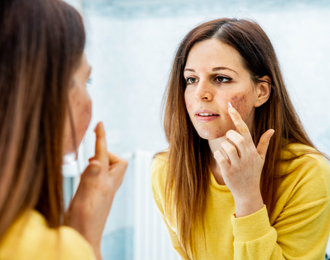Substance use during the pandemic

By Ashley Abramson
March 2021
Opioid and stimulant use is on the rise—how can psychologists and other clinicians help a greater number of patients struggling with drug use?
The ongoing stress and uncertainty of COVID-19 have led to increased demand for mental health services from psychologists in the United States—but conditions like anxiety and depression aren’t the only mental health issues people are facing. Experts say misuse of opioids and stimulants is also on the rise—and psychologists are in a good position to help.
On top of the other risks arising with substance misuse, those with substance use disorders (SUD) are both more likely to develop COVID-19 and experience worse COVID-19 outcomes, including higher risk of hospitalization and mortality.
According to the Centers for Disease Control and Prevention, as of June 2020, 13% of Americans reported starting or increasing substance use as a way of coping with stress or emotions related to COVID-19. Overdoses have also spiked since the onset of the pandemic. A reporting system called ODMAP shows that the early months of the pandemic brought an 18% increase nationwide in overdoses compared with those same months in 2019.
The trend has continued throughout 2020, according to the American Medical Association, which reported in December that more than 40 U.S. states have seen increases in opioid-related mortality along with ongoing concerns for those with substance use disorders.
Mandy Owens, PhD, a clinical psychologist and researcher at the University of Washington Alcohol and Drug Abuse Institute, says she’s observed a spike in substance use that includes an increase in both quantity and frequency of drug use during the pandemic. Some people who use substances may have also started new drugs if their usual substances became more difficult to access.
For example, Owens says Washington state has seen an uptick in the use of fentanyl, a synthetic opioid that’s increasingly produced illicitly, due to a shift in drug supply availability. But precise data on use and drug type are hard to come by, according to Wilson Compton, MD, MPE, deputy director of the National Institute on Drug Abuse.
Health care records are the primary source of data on substance use, and it can take months for medical providers to provide toxicology reports for overdose incidents to the CDC, says Sharon Walsh, PhD, a professor of behavioral science, pharmacology, pharmaceutical sciences, and psychiatry at the University of Kentucky (UK) and director of the UK Center on Drug and Alcohol Research. Tracking substance use accurately also heavily depends on the ability to do door-to-door household or school-based surveys, which have been more difficult to conduct during the pandemic.
However, Walsh says state-level data are a bit clearer. According to her research, Kentucky has seen increased emergency room visits for overdose-related incidents during the pandemic. By contrast, the state experienced a decline in emergency medical service runs for non-opioid related emergencies. “It really magnifies the opioid problem when you look at it against a decline in presentation at the hospital for other conditions,” she says.
The relationship between the pandemic and drug use
Compton cautions against conflating all increased drug use directly with COVID-19. For example, shifts in drug availability may also be to blame for increased illicit opioid use deaths; if heroin isn’t easy to access, someone might take fentanyl, which is much stronger. But experts agree based on research and clinical observation that pandemic-related strains, from economic stress and loneliness to general anxiety about the virus, are a major driver for the increase.
“There’s sort of a perfect storm of factors that we know increase drug use,” says William Stoops, PhD, a professor of behavioral science, psychiatry and psychology at the University of Kentucky. “People are more stressed and isolated, so they make unhealthy decisions, including drinking more and taking drugs.” (See January Monitor for more on drinking habits during COVID-19.)
As their stress increases, people may have fewer ways to manage it, which Owens says probably contributes to the uptick in substance misuse. For example, resilience-promoting activities, like physical activity and social interactions, haven’t been as safe to engage in or easy to access, which can lead some people to start using drugs or use them more often or in greater amounts.
There are also practical pandemic-related reasons for the rise in overdoses. Compton says people are more likely to die when they are using drugs alone, because there’s no one there to call 911 or administer naloxone, an opioid-reversal agent. For those living alone during the pandemic, this isolation presents an obvious risk. And in the early part of the pandemic, it was more difficult for people to seek the medical care they needed for recovery from opioid use because some clinics and community-based organizations decreased their services.
Walsh says that in March and April, Kentucky methadone clinics saw an increase in patients ending treatment and a decrease in new patients starting treatment. “Physicians have been concentrating largely on COVID-19, and medical systems are overwhelmed, so people can’t always access the care they need,” says Stoops.
“There’s also a stigma around substance use disorder that keeps people away from treatment, and even more so during a pandemic.”
A shift toward telemedicine
Fortunately, it’s become easier throughout the pandemic for people to access care for substance use disorders, thanks to the increased availability of telemedicine for behavioral health concerns. While the pandemic initially caused many clinics and community-based organizations to close their doors, telehealth options for physical and mental health problems have become increasingly available as insurance providers and organizations have recognized the need.
In addition, it’s becoming more common for community-based groups like Narcotics Anonymous and Alcoholics Anonymous to meet virtually. And most insurers, including Medicaid, have lifted previous telehealth restrictions on treatment for behavioral health, including substance use disorder.
For example, Compton says physicians can now start patients on buprenorphine, a drug used for opioid recovery, through telehealth without conducting an in-person exam. Opioid Treatment Program providers (at so-called “methadone clinics”) have also been offering patients take-home methadone for maintenance more frequently during the pandemic.
“Normally you have to be extraordinarily stable to take as many as 30 doses at a time home, but they’ve relaxed some of those [requirements] so patients don’t have to show up every day to an opioid treatment program,” Compton says.
Better access to telehealth means people with substance use issues can also seek remote mental health care. While Owens says accessing treatment can be difficult for people without reliable internet or phone service, according to Compton, clinicians are largely reporting more patients showing up for psychotherapy appointments thanks to the increasing use of telehealth.
“One clear benefit of changes in treatment infrastructure throughout the pandemic is that the availability of telehealth may have helped some folks that were on the precipice of seeking help go seek that help,” says Justin Strickland, PhD, a postdoctoral fellow in behavioral pharmacology at the Johns Hopkins University School of Medicine.
What psychologists can do to help
Psychologists are well positioned to support patients struggling with substance use disorders. But how they help their patients depends on the type of drug. For opioid use disorder, medications like buprenorphine are a key component of treatment. Owens says encouraging patients to seek medical treatment is the first step to preventing long-term impact of opioid use, including overdose.
Concurrent psychological treatment can help people adhere to the medication schedule, identify, and respond in more healthy ways to stressors that have led them to opioid use, and address related conditions such as pain, post-traumatic stress, anxiety, and depression.
According to Paul Christo, MD, an associate professor in the Division of Pain Medicine at the Johns Hopkins University School of Medicine, it’s also important for psychologists to advocate for expanded availability of naloxone, which, in certain states, anyone can request from a pharmacy to have on hand to treat narcotic overdose in emergencies. “We need greater awareness around the country that this is something that can prevent someone from dying,” Christo says.
There are no FDA-approved medication physicians can use to help patients recover from use of stimulants, such as cocaine and methamphetamine, but Stoops says there are a number of behavior-based interventions, such as cognitive behavioral therapy (CBT), that psychologists can use to help. Some clinicians couple CBT with an approach called contingency management, which promotes abstinence by providing alternative reinforcers like gift cards or vouchers when patients show they have not used drugs.
Psychologists should also make a habit of asking all their patients about any substance use. Owens encourages clinicians not to assume patients without a SUD diagnosis aren’t misusing substances or at risk for misuse in the future. “As stressors have continued and effective coping skills have been cut off, it’s more likely for people to turn to substances,” she says.
If a patient says they have been using, Owens encourages clinicians to extend compassion, with the goal of helping patients understand how compounding stressors may be influencing their substance use and identify better ways to cope. “Instead of assuming people want to quit using, psychologists should help patients do a functional analysis of the substance’s role in their lives,” she says.
It’s also important, Owens says, to recognize that weekly outpatient appointments might not be enough for every patient, especially those with more free time on their hands during the pandemic. Psychologists should coordinate care with other providers as needed, focusing on adding as much structure and support to their patients’ routine as possible.
For example, Owens treats a patient with a SUD in an outpatient setting once weekly, but the patient also participates in intensive outpatient care through another local provider. Psychologists should also consider encouraging patients to participate in virtual community support groups, adds Owens. There’s no black-and-white approach to helping patients struggling with substance use, she says. “It’s really about tailoring to what each patient needs.”





